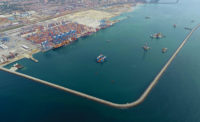In her journey, Harriet—named by Miami-Dade County Girl Scouts for Harriet Tubman, the Underground Railroad heroine—had less than 22 ft of buffer above her and below the highway. She had to travel down, at most, a 5% grade—at one point mere feet from the bottoms of port facilities and ships. The route's only flat, straight section is at the very bottom and runs for about eight feet, says Brais. Bouygues decided to lengthen the tunnel alignment by an extra 150 ft at each end, so that Harriet could avoid the hard-rock layers. Bouygues also value-engineered the tunnels' two launch boxes into one.
Of the need for lengthening, Brais says, "We could not excavate layer five [a hard limestone] under water, and we had no lateral access to the box on Watson Island—there are highway lanes on each side." Thus, at the start of tunneling, the TBM's topside would be above ground. To provide sufficient cover for Harriet, crews built a 17-ft-high overburden of roller-compacted concrete pad combined with a geogrid for the first 400 ft.
Due to the longer alignment, the two tunnels come within 15 ft of each other at the ends. Launch shafts could not have slurry walls due to the weak and permeable layers, nor sheet piles due to the strong layers. So, the team opted for cutter soil mixing (CSM), in which paddles rotate to mix cement and soil.
San Francisco-based Malcolm Drilling Co. won an approximately $40-million contract to build a temporary excavation support system of steel-reinforced CSM walls, combined with a 5-ft-thick tremie seal slab reinforced with 160-ft-long tiebacks. The 9-ft-long, 4-ft-wide CSM panels create a 3D tic-tac-toe-like grid, says Joe Folco, Bouygues commercial manager. The holes within the grid are filled with 12-ft-dia unreinforced secant piles. Monolithic, watertight walls resulted. Down to 120 ft, it is the deepest-ever application of CSM, officials say.
In a compressed-air chamber—necessary when working deep under water—crews periodically inspect the cutterhead for wear and tear. Because of the extremely porous ground conditions, the "hyperbaric interventions were very challenging," says Brais. "Early on in the east-bound launch, we attempted it 16 times. We could not develop the confinement area for the compressed air we needed, so we looked at the CSM technique again." Harriet's cutter face is submerged in CSM "refuge" blocks at about 700-ft intervals, so crews can safely conduct inspections without water intrusion and water pressure.
In EBPM tunneling, a screw conveyor ingests the excavated material and excretes it onto a conveyor system, which takes it out of the tunnel. However, when digging through the infamous coralline-limestone layer, the material is discharged into a 12-in.-dia pipe, then impelled out of the tunnel by the pipe's water pressure, says Folco. Outside, machines separate the coarser materials from the finer sands, remove the silts and produce dried-out cakes of the coralline limestone. Expected to total 400,000 cu yd, the muck is trucked away at night, for use in parks and landfills.
About a third of the construction consists of above-ground work, says Brais. To make room for the plant area, which includes concrete batch mixing for the 12,100 precast tunnel-lining segments, the team rebuilt a MacArthur Causeway bridge span 100 feet out. Furthermore, the team is building lanes to take dedicated port traffic directly to and from the interstate highways.
Durability Debate
From the beginning, the main design requirement for the concrete was durability, not strength. But since no design standard existed for the 150-year life span mandated by the contract, Bouygues and FDOT had to figure one out. "The issue is, how do you prove 150 years?" says Mark Scott, Bouygues quality and environmental manager. "There's nothing in the codes."
Victor Ortiz, an FDOT consultant from CSA Group, says FDOT relied heavily on a model sponsored by the American Concrete Institute that assumes corrosion of reinforcing steel from chloride ingress as the main cause of degradation. Ultimately, the Bouygues team based its design on the DuraCrete/DARTS system, which considers a wide range of factors related to items such as chloride ingress, depth of concrete covering the reinforcing steel, curing, temperature and age. Scott says this system uses the Monte Carlo method of running thousands of repeated calculations.
"In Europe, I guess they're more aggressive on their designs," says Ortiz. "But we were able to come to an agreement by sharing our experience on the current environment with their innovative design." The resulting mix includes cementitious substitutes fly ash and slag to aid durability, says Scott. For strength, FDOT required 6,000 psi at 28 days; the contractor says it is achieving roughly 9,000 psi.
Depth of concrete cover was another debate. FDOT wanted each 2-ft-thick panel to have three inches of cover over the reinforcing steel—about twice the depth Bouygues thought necessary. The 3-in. cover is "more than what we're accustomed to doing, and it brings an uncertainty into the segment erection process," says Scott. "Three-inch cover on segments is not common." Scott says Miami was the first time but adds that other owners have since asked for the 3-in. cover.







Post a comment to this article
Report Abusive Comment